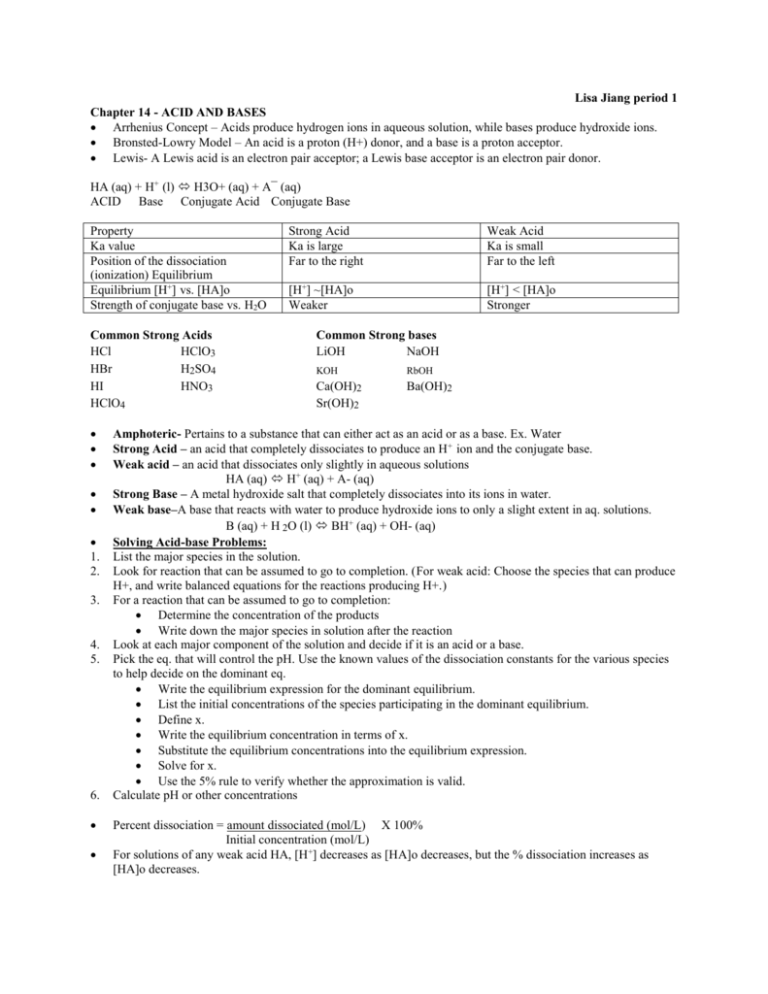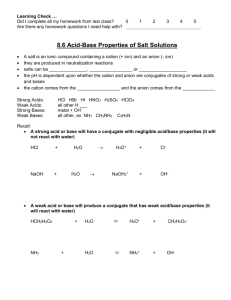Chapter 14 - ACID AND BASES
advertisement

Lisa Jiang period 1 Chapter 14 - ACID AND BASES Arrhenius Concept – Acids produce hydrogen ions in aqueous solution, while bases produce hydroxide ions. Bronsted-Lowry Model – An acid is a proton (H+) donor, and a base is a proton acceptor. Lewis- A Lewis acid is an electron pair acceptor; a Lewis base acceptor is an electron pair donor. HA (aq) + H+ (l) H3O+ (aq) + A¯ (aq) ACID Base Conjugate Acid Conjugate Base Property Ka value Position of the dissociation (ionization) Equilibrium Equilibrium [H+] vs. [HA]o Strength of conjugate base vs. H2O Common Strong Acids HCl HClO3 HBr H2SO4 HI HNO3 HClO4 1. 2. 3. 4. 5. 6. Strong Acid Ka is large Far to the right Weak Acid Ka is small Far to the left [H+] ~[HA]o Weaker [H+] < [HA]o Stronger Common Strong bases LiOH NaOH KOH RbOH Ca(OH)2 Sr(OH)2 Ba(OH)2 Amphoteric- Pertains to a substance that can either act as an acid or as a base. Ex. Water Strong Acid – an acid that completely dissociates to produce an H+ ion and the conjugate base. Weak acid – an acid that dissociates only slightly in aqueous solutions HA (aq) H+ (aq) + A- (aq) Strong Base – A metal hydroxide salt that completely dissociates into its ions in water. Weak base–A base that reacts with water to produce hydroxide ions to only a slight extent in aq. solutions. B (aq) + H 2O (l) BH+ (aq) + OH- (aq) Solving Acid-base Problems: List the major species in the solution. Look for reaction that can be assumed to go to completion. (For weak acid: Choose the species that can produce H+, and write balanced equations for the reactions producing H+.) For a reaction that can be assumed to go to completion: Determine the concentration of the products Write down the major species in solution after the reaction Look at each major component of the solution and decide if it is an acid or a base. Pick the eq. that will control the pH. Use the known values of the dissociation constants for the various species to help decide on the dominant eq. Write the equilibrium expression for the dominant equilibrium. List the initial concentrations of the species participating in the dominant equilibrium. Define x. Write the equilibrium concentration in terms of x. Substitute the equilibrium concentrations into the equilibrium expression. Solve for x. Use the 5% rule to verify whether the approximation is valid. Calculate pH or other concentrations Percent dissociation = amount dissociated (mol/L) X 100% Initial concentration (mol/L) For solutions of any weak acid HA, [H+] decreases as [HA]o decreases, but the % dissociation increases as [HA]o decreases. Polyprotic Acids (dissociates in a stepwise manner, one proton at a time) Monoprotic Acid- An acid with one acidic proton Diprotic Acid- an acid with two acidic protons Triprotic Acid- an acid with three acidic protons Oxyacid-an acid in which the acidic proton is attached to an oxygen atom Organic acid- an acid with a carbon atom back bone, often contains the carboxyl group. Characteristics of Weak Polyprotic acid Successive Ka values are smaller than the first value that only the first dissociation step makes a significant contribution to the equilibrium concentration of H +. The calculation of the pH for a solution of a typical weak polyprotic acid is identical to that for a solution of a weak monoprotic acid. H2SO4 is unique in being a strong acid in its first dissociation step and a weak acid in its second step. For concentrated solutions of sulfuric acid, the larger [H+] from the first dissociation step represses the 2 nd step, which can be neglected as a contributor of H+ ions. For diluted solutions for sulfuric acid, the second step does make a significant contribution and the quadratic equation much be used to obtain the total [H+]. Salt –consist of the cations of strong bases and the anions of strong acids have no effect on [H+]. For any salt whose cation has neutral properties (such as Na + or K +) and whose anion is the conjugate base of a weak acid, the aq solution will be basic. In a base reaction, a base reacts with water to produce OH- and a conjugate acid. Ka x Kb= Kw Type of Salt Strong base cation and strong acid Anion Examples Strong base + Weak acid Cation is conjugate acid of weak base, anion is from strong acid. Cation is conjugate acid of weak base, anion is conjugate base of weak acid Cation is highly charged metal ion, anion is from strong acid pH of salt solution Neutral NaC2H3O2, KCN, NaF NH4Cl, NH4NO3 NH4C2H3O2, NH4CN Anion acts as a base, Cation has no effect on pH Cation acts as an acid, anion has no effect on pH Basic Cation acts as an acid, anion acts as a base Al(NO3)3, FeCl3 Hydrated cation acts as an acid, anion has no effect on pH Acidic if Ka> Kb Basic if Kb>Ka Neutral if Ka = Kb Acidic KCl, KNO3, NaCl, NaNO3 Acidic 2 main factors that determine whether a molecule containing an X-H bond will behave as a Bronsted-Lowry acid. 1. Strength of the bond 2. Polarity of the bond. 2. Comment Neither acts as an acid or a base (Most polar) H-F > H-Cl > H-Br > H-I (least polar) *H-F is a weak acid, the bond is strong. HOCl, HOCl2, HOCl3, HOCl4 – Strength increase as the number of oxygen atoms increase because the very electronegative oxygen atoms are able to draw electrons away from the Cl atom and the O-H bond. The net effect is to both polarize and weaken the O-H bond. Acidic Oxides- when a covalent oxide dissolves in water, an acidic solution forms Nonmetal oxide + H2O => Acid ex: SO4 + H2O => H2SO4 Metal Oxide + H2O => Base ex: CaO + H2O => Ca (OH) 2 Hydrated highly charged metal ions generic reaction: 1. M(H2O)nz+ (aq) => M(H2O)(n-1)(OH)(z-1)+ (aq) + H+ (aq) 2. M(H2O)nz+ (aq) + H2O (l) => M(H2O)(n-1)(z-1)+ (aq) + H 3O+ (aq) Formulas Ka = [H3O+][A¯ ] [HA] Kw = [H3O+][OH-] [H3O+] = [OH-] Ka = Kb [H3O+] < [OH-] Ka > Kb [H3O+] > [OH-] Ka < Kb pH = -log[H+] pOH = -log[OH-] pH + pOH = 1.0 E -14 [H3O+][OH-] = 1.0 E-14 Percent dissociation = amount dissociated (mol/L) X 100% Initial concentration (mol/L) Ka x Kb= Kw Chapter 14 5 Multiple Choice Questions: 1 What is the pH of a 0.15 M solution of formic acid, HCOOH? Ka= 1.9E-4 a) 1.49 c) 3.72 b) 2.27 d) 4.55 2. What will happen to the pH of a buffer solution when a small amount of a strong base is added? The pH will a) increase slightly c) remain exactly the same b) decrease slightly d) become 7.0 3. Acetylsalicylic acid (aspirin) behaves as an acid according to the equation Calculate the Kb for the C9H7O4¯ (aq) ion. (Ka= 3.0E -4) a) 3.0 E -17 b) 3.3 E -11 c) 9.0 E -8 d) 3.3 E 3 4. When solid silver chloride (MM=143.4) is added to 100. mL of H2O, 1.9 E -4 g dissolves. What is the Ksp for silver chloride? a) 1.3 E -5 b) 3.7 E -8 c) 3.7 E -6 d) 1.8 E -10 5. The dihydrogen phosphate ion undergoes these reactions in water. What is the conjugate base of HPO 4¯? Multi-part Free-response Question: 1. A weak base, Aniline, reacts with water according to the reaction below. C6H5NH2 (aq) + H2O (l) C6H5NH3+ (aq) + OH-(aq) a) Write the equilibrium constant expression, Kb, for the reaction represented above. b) A sample of aniline is dissolved in water to produce 25.0 mL of a 0.10 M solution. The pH of the solution is 8.82. Calculate the equilibrium constant, Kb for this reaction. c) The solution prepared in part b is titrated with 0.10 M HCl. Calculate the pH of the solution when 5.0 mL of the acid has been added. d) Calculate the pH at the equivalence point of the titration in part c. Answers to the multiple choice: 1) B Calculations: HA => H+ + A¯ 0.15 0 0 -x +x +x 0.15-x x x Ka = 1.9E-4 = [H+] [A-]/ [HA] = x^2 / 0.15 –x Ka is too small, assume x is negligible. 1.9E -4 = x^2 / 0.15 x = 0.0053 Check 5% rule: 0.0053 / 0.15 < 0.5 2) A 3) B Calculations: Ka = 3.0 E -4 Ka/Kb = Kw 1.0E-14 / 3.0 E -4 = 3.3E -11 4) D 5) Calculations: 6) AgCl => Ag+ + --0 +x x pH = - log (00.0053) = 2.27 Cl¯ 0 +x x Ksp = [Ag+][Cl-] = x^2 = (1.32E-5) = 1.8E-10 1.9E -4 g X 1 mole X 1 143.4 g 0.100L 7) A = 1.32E -5 M Answer to the multi-part free response: a) Kb = [C6H5NH3+][OH¯] [C6H5NH2] b) pH = 8.82 pOH = 14- 8.82 = 5.18 [OH¯] = 10^-5.18 = 6.61 E-6 M [C6H5NH3+] = [OH¯] = 6.61 E -6 M Kb = [C6H5NH3+][OH¯] = ( 6.61 E-6 ) ^2 [C6H5NH2] 0.10 Kb = 4.4E -10 c) I C E 0.025 L ( 0.10M) = 0.0025 mol C6H5NH2 0.0050 L (0.10 M = 0.00050 mol HCl or H+ C6H5NH2 (aq) + 0.0025 mol -0.0050 0.0020 H+ (aq) 0.00050 mol -0.00050 0 0.00020 mol / (0.030 L) = 0.0667 M 0.00050 mol / 0.030 L = 0.0167 M I C E C6H5NH2 (aq) + H2O (l) C6H5NH3+ (aq) + OH-(aq) 0.0667 0.0167 0 -x +x +x 0.0667 –x 0.0167 +x x C6H5NH3+ (aq) 0 mol + 0.00050 0.00050 Kb = 4.37 E -10 = (0.167 + x)(x) = (0.0167)(x) = 1.75 E -9 M = [OH-] (0.0667 –x) 0.0667 Assume x is negligible because Kb is too small. Check 5 % rule: 1.75E -9 / 0.0667 < 0.5 pOH = - log(1.75E-9) = 8.76 pH = 14 – 8.76 = 5.24 d) At the equivalence point: moles of C6H5NH2 = moles of H+ C6H5NH2 (aq) + H+ (aq) C6H5NH3+ (aq) I 0.0025mol 0.0025mol 0 C -0.0025 -0.0025 +0.0025 E 0 0 0.0025 0.0025 mol / 0.050 L = 0.050 M I C E C6H5NH3+ (aq) 0.0050 M -x 0.0050 –x C6H5NH2 (aq) 0 +x x Ka = Kw/ Kb = 1.0 E-14 / 4.4 E -10 = 2.3 E-5 Ka = 2.3 E -5 = x^2 / (0.050 –x) Assume x is negligible, because Ka is too small. 2.3 E -5 = x^2 / 0.050 x = 1.1 E -3 M = [H+] Check 5% rule: 1.1E-3 / 0.050 < 0.5 pH = -log (1.1 E-3) = 2.96 + H+ (aq) 0 +x x






